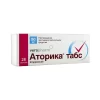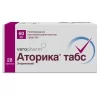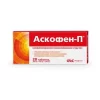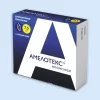Description
Paracytolgin Pharmacodynamics
A combined preparation, the action of which is due to its constituent components. It has a directed action against pain (analgesic), antipyretic and anti-inflammatory effects.
Ibuprofen and paracetamol differ in mechanism and site of action. As a result of their mutually reinforcing action, a more pronounced decrease in pain sensitivity and increased antipyretic effect is achieved than separately.
Ibuprofen is a non-steroidal anti-inflammatory drug (NSAID) that has analgesic, anti-inflammatory, antipyretic effects. Inhibiting cyclooxygenase (COX) 1 and 2, disrupts metabolism of arachidonic acid, reduces the number of prostaglandins (mediators of pain, inflammation and hyperthermia), both in the focus of inflammation and in healthy tissues, inhibits the exudative and proliferative phases of inflammation. Ibuprofen inhibits migration of leukocytes to the center of inflammation.
Analgesic effect of ibuprofen is provided by its inhibitory effect at the peripheral level. The antipyretic effect of ibuprofen is associated with central inhibition of prostaglandin synthesis in the hypothalamus.
Paracetamol is an analgesic non-narcotic agent and has analgesic, antipyretic and mild anti-inflammatory effects. Paracetamol indiscriminately blocks COX, mainly in the central nervous system, has little effect on water-salt metabolism and the mucosa of the gastrointestinal tract (GIT). It has analgesic and antipyretic effects. Paracetamol can also stimulate the activity of descending serotonin pathways, which leads to knocking out the transmission of the pain impulse in the spinal cord. At the peripheral level, paracetamol has a weak effect on COX-1 and COX-2.
It relieves arthralgia at rest and during movement, reduces morning stiffness and swelling of joints, helps to increase range of motion.
Indications
– Headache (including migraine);
– toothache;
– back pain;
– myalgia;
– Algodysmenorrhea (painful menstruation);
– neuralgia;
– Joint pain, pain syndrome in inflammatory and degenerative diseases of the joints and spine;
– Pain from contusions, sprains, dislocations, fractures;
– Post-traumatic and postoperative pain syndrome.
– febrile states (including the flu and colds), accompanied by fever, chills, headache, pain in muscles and joints, sore throat.
The drug is intended for symptomatic therapy, to reduce pain and inflammation at the time of use. The drug has no effect on the progression of the disease.
Contraindications
Increased individual sensitivity to the components of the drug (including other NSAIDs).
Gastrointestinal erosive and ulcerative diseases (including gastric and duodenal ulcers, Crohn’s disease, ulcerative colitis) or ulcer bleeding in the active phase or in the history (two or more confirmed episodes of ulcer disease or ulcer bleeding).
Cerebrovascular or other bleeding.
Hemophilia or other clotting disorders (including hypocoagulation), hemorrhagic diathesis, intracranial hemorrhage.
Severe renal failure (creatinine clearance (CK) less than 30 ml/min).
Complete or incomplete combination of bronchial asthma, recurrent polyposis of the nose and sinuses, and intolerance to acetylsalicylic acid or other NSAIDs (including history).
Severe heart failure (NYHA class IV).
Decompensated heart failure.
Optic nerve damage.
Genetic absence of glucose-6-phosphate dehydrogenase.
Diseases of the blood system.
Period after coronary artery bypass grafting.
Progressive kidney disease.
Severe liver failure or active liver disease.
Confirmed hyperkalemia.
Pregnancy over 20 weeks.
Childhood under 18 years of age.
Dosage and administration
- Inside (before a meal or 2-3 hours after a meal), without chewing, drinking plenty of water.
- One tablet three times a day. The maximum daily dose is 3 tablets.
- Duration of treatment no more than 3 days as an antipyretic and no more than 5 days as an analgesic. Continued treatment with the drug is possible only after consultation with a doctor.










